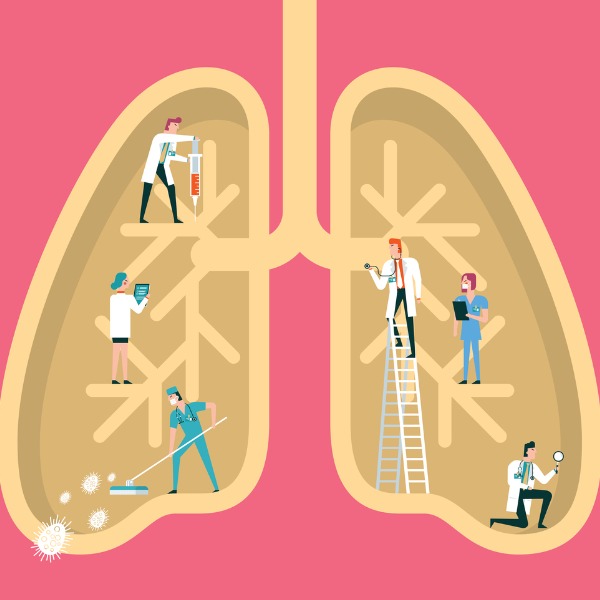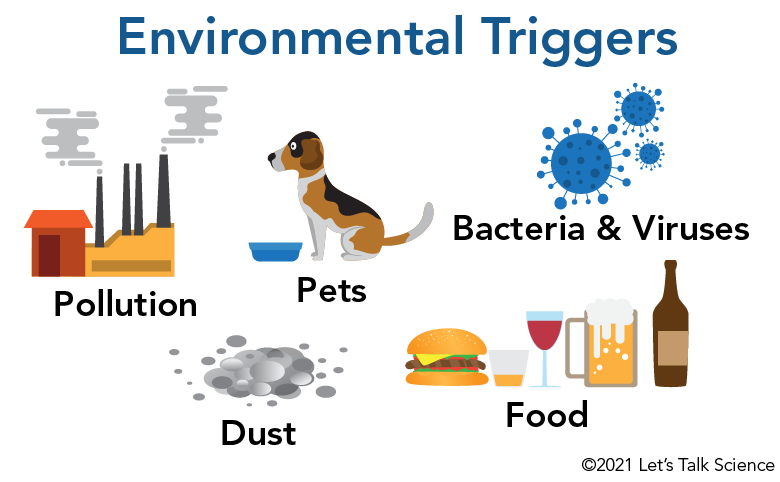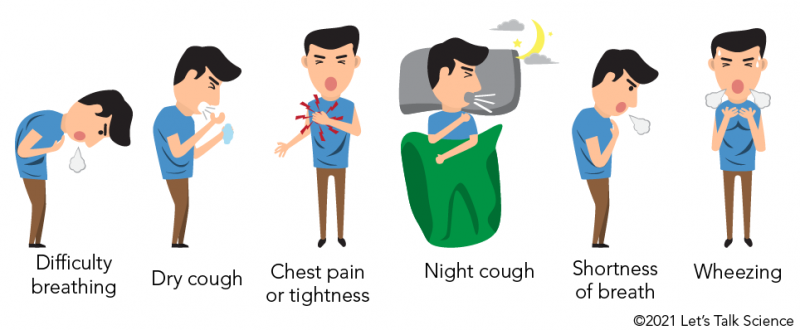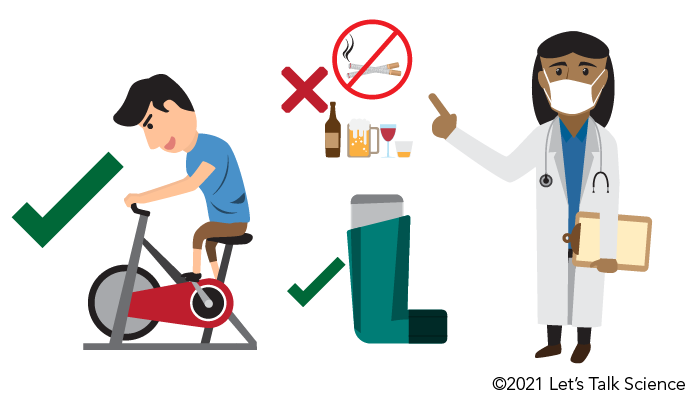Just Breathe: Lungs and Asthma

Human lungs with scientists inside (sorbetto, iStockphoto)

Human lungs with scientists inside (sorbetto, iStockphoto)
How does this align with my curriculum?
Learn about asthma and what scientists are doing to study it.
Take a Breath!
Taking in a breath of fresh air and breathing deep into your lungs may be something you take for granted. Most of us do it every day without even thinking about it. But have you ever stopped and wondered how often you breathe on a normal day or even why you breathe in the first place?
Did you know that the average person breathes approximately 15 times a minute? That’s 22 000 breaths in a single day! Each breath brings in oxygen. Your body needs oxygen to help provide energy to your cells. Each breath also gets rid of carbon dioxide. This is a waste product your body makes from using energy. The body system that makes all this work is your respiratory system. Your lungs are the stars of that system.
When Our Lungs Don’t Work
As scientists we want to understand how exactly lungs work. We also want to understand why lungs sometimes don’t work as well as they should. One thing we are interested in is whether climate and the environment have an impact on lungs. At my work, we work to discover medicines that can help people breathe easier.
In everyday life, your breathing can be impacted by different situations. For example, have you ever taken in a breath of really cold air and felt a brief burning sensation in your airways or felt the need to cough? This is a normal reaction to air that isn’t warmed or moistened quickly enough as it passes through your airways. The result is a brief spasm in your airways, called a bronchospasm. But don’t worry - you can’t freeze your lungs! Perhaps you have had a bad infection that made it more difficult to breathe. Or perhaps you find breathing a little more difficult when accidentally inhaling smoke from a campfire.
For some individuals with diseases such as asthma, breathing is difficult in the same ways. In each of the situations above, inflammation of your lungs is taking place.
When your lungs become inflamed the bronchial tubes narrow, making it difficult for the air to pass through.
Image - Text Version
Shown is a colour illustration of bronchial tubes in three different states. In each case, a simple cross-section of a bronchial tube is shown. The image on the left shows a normal bronchial tube. The tube is fully open, with a thin pale pink inner lining layer around the edge of the tube. The image in the centre is of a bronchial tube belonging to someone with asthma. The bumpy pale pink inner lining of the tube extends almost half way to the centre of tube, which cuts down on airflow. The image on the right is of a bronchial tube belonging to someone having an asthma attack. The pale pink inner lining of the tube extends almost to the centre of tube, cutting off airflow to the lungs.
Triggers such as smoke and allergens can cause your lungs to constrict more, further blocking airflow to the lungs.
Climate and the environment therefore have a very important role to play in breathing as changes in temperature or the presence of pollutants and allergens in the air can all have an impact on breathing.
Image - Text Version
Shown is an infographic of environmental triggers that can impact breathing. There are five sets of images. The top left image shows a factory with smoke coming out of two smokestacks. The trigger is pollution. The top centre image is of a black, brown and white dog sitting with a blue bowl in front of it. The trigger is pets. The top right image is three large viruses. The trigger is bacteria and viruses. The bottom left image is a pile of small grey material. The trigger is dust. The bottom right image is a hamburger, a glass partly filled with an orange liquid, a wine glass filled with red wine, a beer mug filled with beer and a brown wine bottle. The trigger is food.
Developing Treatments
At my work, our goal is to develop improved medicines to treat conditions such as asthma. Asthma is a common condition that often starts in childhood but can affect people of all ages. It is a chronic condition that can affect people for a long time. For many children, their asthma clears up before adulthood.
There are many forms of asthma. They differ in how serious they are, their response to medicines and their underlying causes.
Image - Text Version
Shown is an infographic of asthma symptoms. The same man is shown undergoing six different symptoms. From left to right, in the first image, the man is bending over and breathing hard. The symptom is identified as difficulty breathing. In the second image, the man is coughing. The symptom is identified as a dry cough. In the third image, the man has his left hand against his chest and a pained look on his face. The symptom is identified as chest pain or tightness. The fourth image is the man lying in bed coughing. The symptom is identified as a night cough. In the fifth image, the man is standing and breathing hard. The symptom is identified as shortness of breath. In the sixth image, the man is breathing very hard. The symptom is identified as wheezing.
For example, some types of asthma are considered allergic asthma. This type of asthma can be triggered by what we call allergens such as dust mites or irritants such as smoke. Other types of asthma are not triggered by allergies. These can be caused by high levels of specialized immune cells in the lung tissues.
We need to do research about many aspects of asthma to develop medicines. For example, we need to better understand the role genetics plays in the disease. It is known that children who have a parent with asthma are more likely to suffer from it. We are therefore investigating which genes are associated with asthma and how these genes impact the severity of disease.
We also want to better understand how different immune cells play a role in asthma. By understanding the different types of asthma and what causes them, we can develop specialized medicines. Our goal is to combine our understanding of different asthma types and causes to develop personalized medicines to help those suffering from asthma.
Image - Text Version
Shown is a colour infographic of asthma treatments. On the left is a man in a blue t-shirt and brown shorts pedalling on a stationary exercise bike. Beside this is a large green check mark indicating that this is good behaviour. Beside this is a green and grey bronchial inhaler. Beside this is a green check mark indicating that taking an inhaler is a positive asthma treatment. Above this is alcohol in a variety of glasses and bottles. Beside this is a red x indicating that drinking alcohol is not good for people with asthma. Beside this is a cigarette with a "no-smoking" symbol on it indicating that smoking is not good for people with asthma. On the right is a female doctor wearing a mask and holding a clipboard. She is pointing at the other images suggesting that they are things a person with asthma should or should not do.
Let’s Talk Science appreciates the work and contributions of Christy A. Thomson and Amgen in the development of this Backgrounder.
About Amgen Canada
As a leader in innovation, Amgen Canada understands the value of science. With main operations located in Mississauga, Ontario’s vibrant biomedical cluster, and its research facility in Burnaby, B.C., Amgen Canada has been an important contributor to advancements in science and innovation in Canada since 1991. The company contributes to the development of new therapies and new uses for existing medicines in partnership with many of Canada’s leading healthcare, academic, research, government and patient organizations. To learn more about Amgen Canada, visit www.amgen.ca.
Learn More
Asthma Canada
Asthma Canada has lots of asthma resources as well as ways to connect for asthma support.
How the Lungs Work
This page, from the US National Heart, Lung and Blood Institute, has more information about how lungs work.
References
D'Amato, G., Cecchi, L., D'Amato, M., & Annesi-Maesano, I. (2014). Climate change and respiratory diseases. European Respiratory Review, 23(132), 161-169. https://doi.org/10.1183/09059180.00001714




